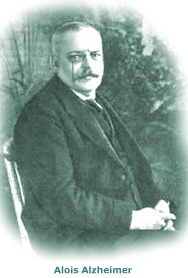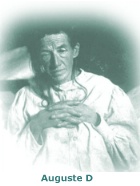 100 Years Ago...
100 Years Ago...
If you would like to print it out in plain text, click HERE
 100 Years Ago...
100 Years Ago...
If you would like to print it out in plain text, click HERE
 The year 2006 marked the 100th anniversary of Dr. Alois Alzheimer's presentation of a case study of a 51-year-old German woman, Auguste D., who had been admitted to a hospital in 1901 with an unusual cluster of symptoms. Those symptoms included reduced comprehension and memory, aphasia, disorientation, unpredictable behavior, paranoia, auditory hallucinations, and pronounced psychosocial impairment. When Dr. Alzheimer first observed her in 1903, Auguste D. was bedridden, incontinent, and was becoming increasingly disoriented, delusional, and incoherent. She eventually required assistance to be fed, was unable to speak, and was often hostile. Hospital staff tried to keep her as safe and comfortable as possible, but little else could be done to treat her illness, and she died on April 8, 1906.
The year 2006 marked the 100th anniversary of Dr. Alois Alzheimer's presentation of a case study of a 51-year-old German woman, Auguste D., who had been admitted to a hospital in 1901 with an unusual cluster of symptoms. Those symptoms included reduced comprehension and memory, aphasia, disorientation, unpredictable behavior, paranoia, auditory hallucinations, and pronounced psychosocial impairment. When Dr. Alzheimer first observed her in 1903, Auguste D. was bedridden, incontinent, and was becoming increasingly disoriented, delusional, and incoherent. She eventually required assistance to be fed, was unable to speak, and was often hostile. Hospital staff tried to keep her as safe and comfortable as possible, but little else could be done to treat her illness, and she died on April 8, 1906.
 Dr. Alzheimer used the latest medical techniques and innovations, including a new silver tissue-staining method and greatly improved microscopes, to conduct the post mortem study of Auguste D.'s brain tissue. No stranger to the fields of pathology and psychiatry, Dr. Alzheimer was involved in a wide range of clinical studies of manic depression and schizophrenia. He worked at the Royal Psychiatric Clinic in Munich, Germany, for Dr. Emil Kraepelin, a leading psychiatrist. Dr. Kraepelin believed that most mental illnesses were actually organic brain diseases, as opposed to his rival, Dr. Sigmund Freud, who maintained that most mental illnesses were psychoses of the mind. Dr. Kraepelin's Handbook of Psychiatry, was the first systematic classification of mental diseases.
Dr. Alzheimer used the latest medical techniques and innovations, including a new silver tissue-staining method and greatly improved microscopes, to conduct the post mortem study of Auguste D.'s brain tissue. No stranger to the fields of pathology and psychiatry, Dr. Alzheimer was involved in a wide range of clinical studies of manic depression and schizophrenia. He worked at the Royal Psychiatric Clinic in Munich, Germany, for Dr. Emil Kraepelin, a leading psychiatrist. Dr. Kraepelin believed that most mental illnesses were actually organic brain diseases, as opposed to his rival, Dr. Sigmund Freud, who maintained that most mental illnesses were psychoses of the mind. Dr. Kraepelin's Handbook of Psychiatry, was the first systematic classification of mental diseases.
The first alzheimer's case was presented at a meeting of the South-West German Society of Alienists (alienists were superintendents of early "insane asylums" and were usually psychiatrists) on November 3, 1906. Dr. Alzheimer's paper, "Regarding a Curious Disease of the Cortex," described numerous globs of sticky proteins in the spaces between neuron cells and the tangled bundle of fibrils within cells throughout the cortex.
These sticky proteins (plaques) and fibrils (tangles) had previously been seen only in the brains of much older patients diagnosed with "senile dementia." At age 51, Auguste D. was thought to be far too young to be suffering from senile dementia, and Dr. Alzheimer's disease was initially classified as "presenile dementia." Because of her age, clinicians did not consider the possibility that the plaques and tangles Dr. Alzheimer described could also be the cause of dementia in old age, thus the characterization as presenile dementia.
Dr. Alzheimer and his colleagues studied the histology of 5 cases with similar brain pathologies during the first decade of the new century. Although other researchers had linked the presence of plaques to symptoms of dementia seen in older people, it was Dr. Alzheimer who first observed both plaques and tangles in a younger patient.
It was not until 1910 that the term "Alzheimer's disease" was coined by Dr. Kraepelin in his 8th edition of the Handbook of Psychiatry. He stated that this particular group of cases with extremely serious cell alterations was described by Alzheimer the plaques were excessively numerous and almost one-third of the cortical cells had died off. In their places, were peculiar, deeply stained bundles of neurofibrils. He mentioned "Alzheimer's disease" for the first time, stating, "The clinical interpretation of this Alzheimer's disease is still unclear. Although the anatomical findings suggest that we are dealing with a particularly serious form of senile dementia, the fact is that this disease sometimes starts as early as in the late forties."
In 1912, Dr. Alzheimer accepted an appointment as full professor of psychiatry at the University of Breslau (now Wroclaw, Poland), but his health deteriorated, and he was never able to fully carry out his university duties. From October 1915 onward, Alois Alzheimer became increasingly ill and finally died on December 19, 1915.
"In his day, Dr. Alzheimer's discoveries were enormous strides forward. I believe that, just as Drs. Alzheimer and Kraepelin established the clinical pathways for researching this disease 100 years ago, we are creating strong "foundations" in neuroimaging and genetics in particular for the major discoveries to come", commented Richard A. Hodes, M.D., Director, NIA. "Tremendous progress continues every day toward our efforts to conquer this disease."
"Many of the world's premier scientific thinkers are exploring every aspect of this highly complex disease. We're discovering new information on AD's earliest preclinical phases and intriguing insights into connections with other diseases and conditions," said Marcelle Morrison-Bogorad, Ph.D., Director, Neuroscience and Neuropsychology of Aging Program, NIA. "New research is examining potential preventive mechanisms, molecular sequences, treatment, and caregiver interventions. Though pleased with our achievements, we'll never be satisfied until we find a cure and ways to prevent the disease altogether."
NIH 2007

Hope our logo helps you find your way back to us.